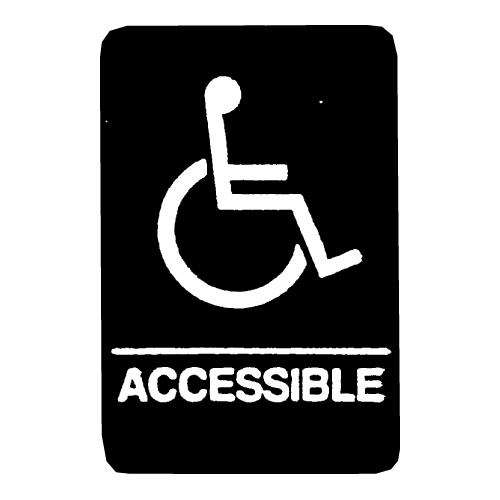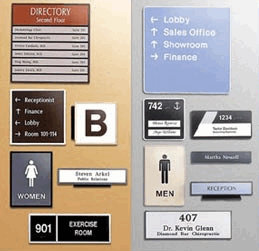The Duty of ADA Signs in Following Access Specifications
The Duty of ADA Signs in Following Access Specifications
Blog Article
ADA Signs: Making Sure Availability and Compliance in Public Spaces
ADA signs plays a vital function in ensuring availability and compliance within public rooms, significantly adding to a comprehensive setting for people with handicaps. By sticking to ADA requirements, signage not only promotes navigating however likewise underscores an organization's dedication to diversity and equal rights. As we check out the subtleties of ADA signage, from responsive features to make complexities, it's crucial to think about how these elements coalesce to copyright the legal rights of all individuals. What are the usual mistakes companies deal with in maintaining compliance, and exactly how can future trends in signage proceed to drive access ahead?
Value of ADA Signs
In modern culture, the relevance of ADA signs extends beyond mere compliance with legal mandates to symbolize a commitment to inclusivity and access for all individuals. These indications are essential in creating environments where individuals with handicaps can navigate public areas with the very same ease and freedom as those without specials needs. By providing clear and standardized info, ADA signs guarantees that everyone can access centers, solutions, and info without obstacles.
The importance of ADA signage hinges on its capability to improve the quality of life for individuals with specials needs by advertising equivalent access. It removes the challenges that may otherwise impede their capacity to take part fully in community life. In addition, these indicators work as noticeable indicators of an organization's commitment to diversity and equality, mirroring broader social worths that promote the civil liberties and dignity of all individuals.
In addition, ADA signs plays an essential duty in public security. By directing people to departures, bathrooms, and other crucial facilities, it makes sure that all people, no matter physical capacity, can leave securely during emergency situations. In recap, ADA signage is not simply a regulatory demand yet an effective tool for promoting a equitable and inclusive society.
Trick Elements of Compliance

Positioning is crucial; signs should be installed in places that are conveniently visible and obtainable. Normally, signage ought to be installed in between 48 and 60 inches from the ground to guarantee access for both standing and mobility device customers. Responsive elements, such as Braille, are necessary for individuals with visual impairments, giving critical information in a non-visual format.
High-contrast colors between the text and background are needed to enhance readability for people with reduced vision. The ADA mandates details contrast proportions to ensure quality. Additionally, character dimension is a crucial consideration, with minimal elevation demands dictated by the viewing distance to make sure readability from different angles.
Design Considerations for Access
Designing easily accessible signs calls for a meticulous technique to ensure it fulfills the demands of all individuals, especially those with impairments. This includes considering different style aspects that improve readability and use. Secret elements consist of the option of font, color contrast, and tactile features. Font styles ought to be sans-serif, with straightforward and clear letterforms, to promote simple reading. The dimension of the message is similarly crucial, with ADA standards suggesting a minimal height based upon checking out range to ensure legibility.
Contrasting colors between message and background are crucial for visibility, specifically for people with visual disabilities. In addition, responsive elements, such as Braille and elevated characters, are essential for people who are blind or have reduced vision.
Moreover, the positioning of signs plays a significant duty in ease of access. Indications must be mounted in areas that are easily obtainable this and unobstructed. Guaranteeing that signs is placed at appropriate elevations and angles makes it possible for all users, including those utilizing mobility devices, to communicate with them effectively.
Common Mistakes to Avoid

One more common error is the incorrect my link positioning of signs. ADA standards specify specific elevation and location needs to ensure that indications are reachable and quickly noticeable by all people, including those making use of wheelchairs. Overlooking these guidelines not just hinders ease of access but additionally runs the risk of non-compliance with lawful standards.
Additionally, not enough contrast in between text and history is a regular oversight. Adequate comparison is vital for readability, especially for people with low vision. Designers sometimes choose shades that are visually appealing but do not have the needed contrast, rendering the message challenging to determine.
Lastly, some designers fail to include tactile elements, such as Braille, which are critical for people who are blind. Omitting these attributes not just results in non-compliance with ADA laws yet also limits gain access to for a section of the population that counts on tactile info.
Future Trends in Signage
Advancements in innovation and increasing recognition of inclusivity are forming the future patterns in signage style. Digital signs, for instance, is advancing to include interactive features and real-time updates, which can be vital in supplying dynamic details in public spaces.
Another arising trend is the utilization of augmented reality (AR) to enhance user experience. AR-enabled signage can overlay electronic information onto the physical atmosphere, giving aesthetically impaired people with auditory or haptic responses. ADA Signs. This modern technology not just boosts availability however additionally creates an appealing experience for all individuals
Sustainability is additionally a significant element affecting signage patterns. Environmentally friendly products and energy-efficient lighting services are being focused on to align with global ecological goals. In addition, developments in materials scientific research are resulting in the growth of more see post weather-resistant and long lasting indicators.
Final Thought
ADA signs plays an essential function in assuring availability and compliance within public areas by integrating responsive aspects, high-contrast colors, and critical positioning. The adherence to ADA standards not just facilitates secure navigating for individuals with handicaps however additionally symbolizes a company's devotion to diversity and inclusivity. By staying clear of common errors and embracing future patterns, public rooms can continue to advance these values, making certain that the civil liberties and dignity of all people are respected and upheld.
ADA signs plays an important function in assuring access and conformity within public spaces, dramatically contributing to a comprehensive atmosphere for individuals with impairments. As we discover the nuances of ADA signage, from responsive attributes to make ins and outs, it's critical to think about just how these components integrate to promote the rights of all individuals.In modern-day culture, the value of ADA signage expands past mere conformity with legal mandates to symbolize a dedication to inclusivity and access for all individuals. By giving clear and standardized information, ADA signage makes sure that every person can access centers, services, and details without barriers.
ADA signs plays a crucial function in ensuring ease of access and conformity within public spaces by incorporating responsive aspects, high-contrast colors, and calculated positioning. (ADA Signs)
Report this page